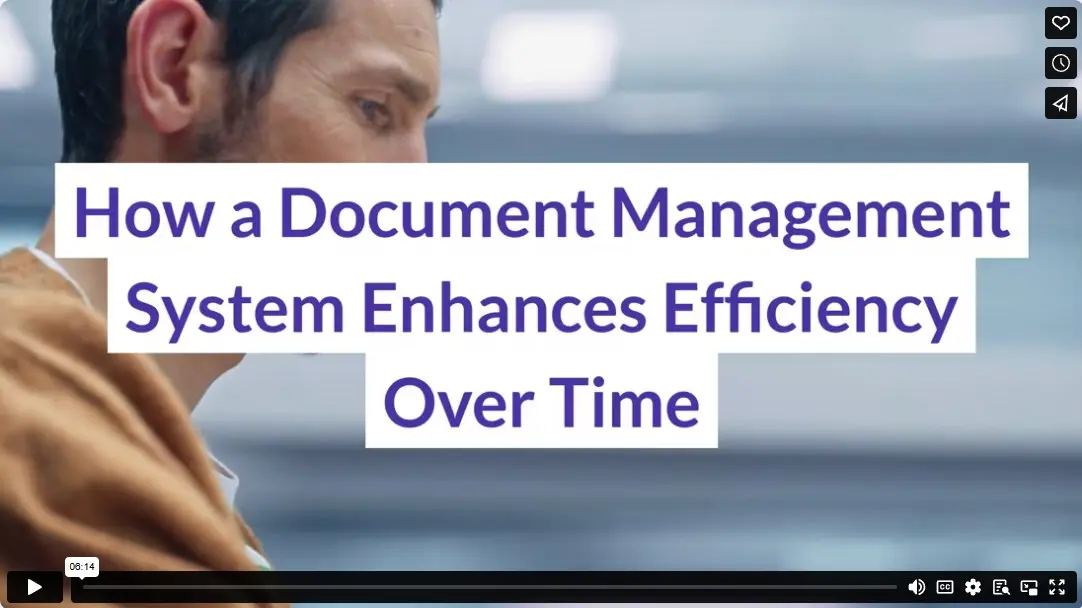Most accounting firms implement a document management system (DMS) for obvious reasons: files are easier to find, there’s less duplication, and everything stays organized in one place.
But the real value grows over time. The longer you use a document management system, the more it improves your operation. Small daily efficiencies compound into significant productivity gains. Here’s how these benefits build over months and years of use.
The Daily Time Savings Add-Up
Every minute you spend searching for a file adds up. Without a DMS, those minutes turn into hours every week. Over time, that’s weeks of lost productivity annually.
When you implement accounting document management software, you eliminate that wasted time. Instead of searching through folder structures or checking multiple email threads, you find what you need instantly using keyword searches, metadata filters, or content previews. As your document database grows, so does the value of these search features.
The time savings multiply across your practice. You can respond to client requests faster, prepare for audits more efficiently, and onboard new staff without hunting for training materials. Tasks close quicker, clients get answers sooner, and tax deadlines become less stressful.
Fewer Mistakes and More Consistency
Over time, inconsistent document handling can lead to lost tax files, outdated client records, or compliance violations. A document management system enforces consistency by controlling access, tracking changes, and managing version histories.
When everyone uses the same platform and follows defined workflows, you avoid errors like working from the wrong tax year or sending incomplete client packages. You also create a built-in safety net: if something goes wrong during an audit, you can trace it, correct it, and prevent it.
Imagine you’re preparing a client’s tax return. With a DMS, you can retrieve the latest forms, access all supporting documents, route them for partner review, and archive everything automatically after filing. As more processes get routed through your system, fewer deadlines are missed, and your entire practice becomes more reliable.
Onboarding and Training Become Easier
When new team members join, the learning curve can be steep, especially if information is scattered or inconsistent.
With a DMS, you create a centralized knowledge base that’s easy to navigate. Onboarding becomes smoother because documentation, guides, SOPs, and previous project files are all in one place. Over time, your DMS becomes an internal playbook, reducing the need for one-on-one training and making institutional knowledge easier to transfer.
This consistency also protects you from knowledge loss when team members leave. Historical files, approvals, and process notes stay within the system. You preserve continuity and speed up transitions by ensuring knowledge doesn’t go out the door when someone changes roles.
Document Security and Compliance Improve With Age
Compliance requirements go beyond current projects. They need historical records, audit trails, and long-term data protection. A well-configured DMS helps you meet these needs effortlessly. The longer you use the system, the more confident you become in your audit readiness. You can produce access logs, track edits, retrieve archived documents, and show who approved what and when.
Your system will also evolve with your industry. As new compliance rules emerge, your DMS adapts. You can set retention policies, automate deletion schedules, and apply access restrictions. Over time, this proactive document management reduces risk exposure and demonstrates professionalism to clients, partners, and regulators.
Enhanced Collaboration Across Teams
As your accounting firm grows, collaboration becomes more complex. A document management system simplifies it. Multiple team members can work on the same tax return, leave notes, and route files for approval automatically.
These workflows become natural over time. Your team works faster without juggling email attachments or losing track of changes. Remote staff and seasonal preparers can access duplicate client files securely, ensuring consistent service wherever they work.
More Intelligent Decision-Making From Historical Insight
Using a DMS for months or years, you build a valuable archive of tax returns, client correspondence, and audit documentation. This institutional memory enables more thoughtful planning. You can compare previous year tax strategies, review past client situations, or analyze the outcomes of tax planning decisions, all within the same platform.
That level of visibility helps you avoid repeating mistakes and identify what works best for each client type. For example, you might reference previous tax returns to handle similar client situations faster. Or revisit prior audit responses to prepare for upcoming reviews. The ability to search and leverage past documentation quickly means your decision-making improves not just in speed but also in quality.
Workflow Automation Reduces Bottlenecks
Many document management platforms have automation tools that become more useful the longer you use them. Start with simple automation, like routing tax return approvals or auto-filing completed client forms. Over time, you can introduce more complex workflows: deadline reminders for missing documents, compliance checks, or escalations for delayed partner approvals.
As you refine these workflows, you’ll identify recurring tasks ripe for automation, eliminating manual steps that once drained your time. Every workflow you automate becomes a new layer of efficiency that frees your team for higher-value client work. Your system evolves with your practice’s needs, learning from your patterns and improving productivity without adding staff.
Bringing It All Together
At first glance, a document management system is another tool for storing files. But the real benefits come with time. The longer you use a DMS, the more it improves your workflows, protects your data, and multiplies your productivity.
From onboarding to compliance, collaboration to automation, the benefits grow layer by layer. What starts as a solution to document clutter becomes the foundation for long-term operational excellence. If you still rely on shared drives, scattered folders, or paper archives, now’s the time to upgrade.




